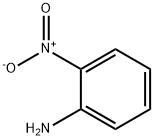2-니트로아닐린
|
|
2-니트로아닐린 속성
- 녹는점
- 70-73 °C (lit.)
- 끓는 점
- 284 °C (lit.)
- 밀도
- 1,255 g/cm3
- 증기압
- 8.1 at 25 °C (Mabey et al., 1982)
- 굴절률
- 1.6349 (estimate)
- 인화점
- 168 °C
- 저장 조건
- Store below +30°C.
- 용해도
- 메탄올: 0.1 g/mL, 투명
- 물리적 상태
- 결정 또는 플레이크
- 색상 색인 번호
- 37025
- 산도 계수 (pKa)
- -0.26(at 25℃)
- 색상
- 주황색에서 갈색으로
- 수소이온지수(pH)
- 6.1 (10g/l, H2O, 20℃)(slurry)
- 수용성
- 1.1g/L(20℃)
- Merck
- 14,6582
- BRN
- 509275
- Henry's Law Constant
- 5.88 x 10-8 atm?m3/mol at 25 °C (thermodynamic method-GC/UV spectrophotometry, Altschuh et al., 1999)
- 안정성
- 안정적인. 산, 산 염화물, 산 무수물, 강산화제, 클로로포르메이트, 헥사니트로에탄과 혼합할 수 없습니다.
- LogP
- 1.85 at 25℃
- CAS 데이터베이스
- 88-74-4(CAS DataBase Reference)
안전
- 위험 및 안전 성명
- 위험 및 사전주의 사항 (GHS)
| 위험품 표기 | T,F | ||
|---|---|---|---|
| 위험 카페고리 넘버 | 23/24/25-33-52/53-39/23/24/25-11 | ||
| 안전지침서 | 28-36/37-45-61-28A-16-7 | ||
| 유엔번호(UN No.) | UN 1661 6.1/PG 2 | ||
| WGK 독일 | 2 | ||
| RTECS 번호 | BY6650000 | ||
| F 고인화성물질 | 8 | ||
| 자연 발화 온도 | 521 °C | ||
| TSCA | Yes | ||
| 위험 등급 | 6.1 | ||
| 포장분류 | II | ||
| HS 번호 | 29214210 | ||
| 유해 물질 데이터 | 88-74-4(Hazardous Substances Data) | ||
| 독성 | LD50 orally in Rabbit: 1600 mg/kg LD50 dermal Rabbit > 7940 mg/kg | ||
| 기존화학 물질 | KE-25962 |
2-니트로아닐린 C화학적 특성, 용도, 생산
화학적 성질
orange solid용도
2-Nitroaniline is the main precursor to?phenylenediamines, which are converted to?benzimidazoles, a family of?heterocycles?that are key components in pharmaceuticals.생산 방법
2-Chloronitrobenzene is heated with excess (10 mol/mol) strong aqueous ammonia in an autoclave. The temperature is gradually increased to 180 ℃ over 4 h and held there for 5 h more. The pressure builds up to around 4 MPa and is released to an ammonia recycle loop before the product is isolated by filtration and washing. The reaction is extremely exothermic, and too rapid heating or inadequate temperature control can result in a runaway reaction. Because of this hazard, I.G. Farbenindustrie developed a continuous amination unit for amination of chloronitrobenzenes; the process is summarized under 4-nitroaniline.일반 설명
Orange solid with a musty odor. Sinks and mixes slowly with water.공기와 물의 반응
Insoluble in water.반응 프로필
2-Nitroaniline may be sensitive to prolonged exposure to light. Mixtures of 2-Nitroaniline with magnesium are hypergolic on contact with nitric acid. 2-Nitroaniline forms extremely explosive addition compounds with hexanitroethane. 2-Nitroaniline has a vigorous reaction with sulfuric acid above 392° F. 2-Nitroaniline is incompatible with acids, acid chlorides, acid anhydrides, chloroformates and strong oxidizers.위험도
Explosion risk. Toxic when absorbed by skin.건강위험
Inhalation or ingestion causes headache, nausea, methemo- globinemia, vomiting, weakness, and stupor; cyanosis caused by contact usually develops in 4-6 hrs.; prolonged and excessive exposure may also cause liver damage. Contact with eyes or skin causes irritation; continued exposure may cause same symptoms as inhalation or ingestion.화재위험
Special Hazards of Combustion Products: Toxic oxides of nitrogen may form in fire.Safety Profile
A poison. Moderately toxic by ingestion. Mildly toxic by skin contact. Mutation data reported. Mixtures with magnesium are hypergolic on contact with nitric acid. Forms extremely explosive addltion compounds with hexanitroethane. Vigorous reaction with sulfuric acid above 200°C. When heated to decomposition it emits toxic fumes of NOx. See also m- NITROANILINE, p-NITROANILINE, and ANILINE DYES.환경귀착
Biological. Under aerobic and anaerobic conditions using a sewage inoculum, 2-nitroaniline degraded to 2-methylbenzimidazole and 2-nitroacetanilide (Hallas and Alexander, 1983). A Pseudomonas sp. strain P6, isolated from a Matapeake silt loam, did not grow on 2-nitroaniline as the sole source of carbon. However, in the presence of 4-nitroaniline, approximately 50% of the applied 2-nitroaniline metabolized to nonvolatile products which could not be identified by HPLC (Zeyer and Kearney, 1983). In activated sludge inoculum, following a 20-d adaptation period, no degradation was observed (Pitter, 1976).Plant. 2-Nitroaniline was degraded by tomato cell suspension cultures (Lycopericon lycopersicum). Transformation products identified were 2-nitroanilino-β-D-glucopyranoside, β-(2- amino-3-nitrophenyl)glucopyranoside, and β-(4-amino-3-nitrophenyl)-glucopyranoside (Pogány et al., 1990).
Purification Methods
Crystallise the aniline from hot water (charcoal), then from aqueous 50% EtOH, or EtOH, and dry it in a vacuum desiccator. It has also been chromatographed on alumina, then recrystallised from *benzene. [Beilstein 12 IV 1563.]2-니트로아닐린 준비 용품 및 원자재
원자재
준비 용품
2-[3-(2H-벤조트리아졸-2-yl)-4-하이드록시페닐]에틸 메타크릴레이트
[5-(프로필시오)-1H-벤지마이다졸-2-일]카르바믹산 메틸 에스테르; 알벤다졸
2-Nitro-4-thiocyanatoaniline
Olaquindox
O-클로로니트로벤젠
Clemizole
2-Bromoaniline
Bathophenanthroline
1-Bromo-2-nitrobenzene
Vat Red 14
MEQUINDOX
4-(Propylthio)benzene-1,2-diamine
Disperse Yellow 119
Pigment Yellow 5
2'-NITROACETANILIDE
2-메르캅토 벤즈이미다졸
8-Nitroquinoline
디니트로 벤젠
3,5-디클로로아닐린
O-페닐렌다이아민








